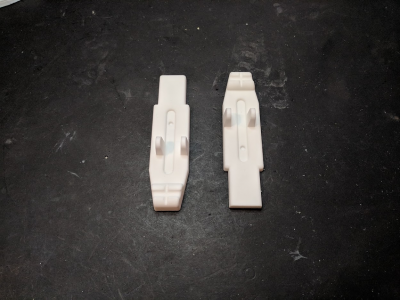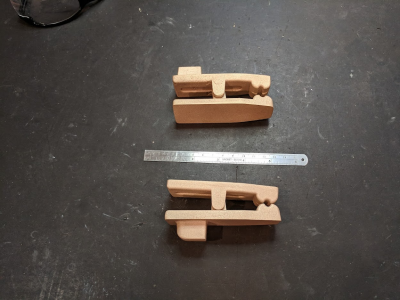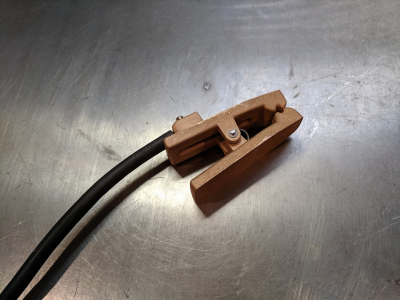I think that hot tears is mainly a problem for castings that have changes in dimension and stress risers. It is not so much a problem for casting rough blanks that will be machined. I don't have that much experience. The main reason I did this was to make some stock for some gear blanks, which incidentally worked just great.I do not worry about shrinkage for dimensional accuracy, but for casting defects such as cracks and hot tears.
-
Welcome back Guest! Did you know you can mentor other members here at H-M? If not, please check out our Relaunch of Hobby Machinist Mentoring Program!
You are using an out of date browser. It may not display this or other websites correctly.
You should upgrade or use an alternative browser.
You should upgrade or use an alternative browser.
Devil Forge users or DIYers.
- Thread starter COMachinist
- Start date
- Joined
- Oct 21, 2014
- Messages
- 2,162
I am also looking to do some of that, I have a bunch of scrap Brass, Copper and AL. What do you use for flux on The various metals.
or degas agents. I have done some brass, and Make my own lead fishing weights. But one try at AL did not go good, due to the bubbles in it.
or degas agents. I have done some brass, and Make my own lead fishing weights. But one try at AL did not go good, due to the bubbles in it.
- Joined
- Mar 25, 2013
- Messages
- 5,107
Gas porosity in aluminum is predominantly from hydrogen dissolved in the melt. Unfortunately with gas fired furnaces, hydrogen in the combustion gases can go directly into the melt. Degassing is complex and it is best to avoid absorbing gas at all. Good melt practices including use of clean metal, rapid melting, keeping the melt at temperature for the minimum time to pour etc. will help reduce gas porosity. Use of an oxidizing atmosphere after achieving melt temperature can help. I am convinced that electric furnaces absorb less H2 but they have their own issues (I have both.) Using casting alloy like A356 will give superior results to scrap extrusion alloy.
Fluxing does not help with degassing. Flux for aluminum is often Lite Salt (Na K Cl mix).
Brass is a whole other animal and I would recommend Ammen's book 'Casting Brass.'
Benmychree is totally correct about mixing leaded and Si bronzes. You should even have separate crucible for these. If you want to cast a really easy bronze try silicon bronze (Everdur.) It makes no dross and pours like water.
Robert
Fluxing does not help with degassing. Flux for aluminum is often Lite Salt (Na K Cl mix).
Brass is a whole other animal and I would recommend Ammen's book 'Casting Brass.'
Benmychree is totally correct about mixing leaded and Si bronzes. You should even have separate crucible for these. If you want to cast a really easy bronze try silicon bronze (Everdur.) It makes no dross and pours like water.
Robert
- Joined
- Aug 22, 2012
- Messages
- 4,260
My first furnace was charcoal and a hair dryer with a tin can for a crucible.
The tin can is suitable for one melt of aluminium but no more.
Mr current furnace was Made from a garbage can and fire proof cement, fired with propane.
Made heaps of castings in aluminium and brass.
The best aluminium cast was a failed melt in a stainless bowel.
It started to leak before I thought it was all melted but it set perfect with no tears or porosity so now I pour as soon as possible and this along with an oxidising flame once it starts melting seems to have minimised porosity really well.
Tears and shrinks can be minimised by ensuring the cast is planned to reduce very thick sections to the minimum.
Machining the cast aluminium is almost like turning wood, the swarf soaks up every scrap of oil everywhere it lands just like sawdust.
I keep meaning to look into heat treating the castings so see if it is possible to improve their machinability
The tin can is suitable for one melt of aluminium but no more.
Mr current furnace was Made from a garbage can and fire proof cement, fired with propane.
Made heaps of castings in aluminium and brass.
The best aluminium cast was a failed melt in a stainless bowel.
It started to leak before I thought it was all melted but it set perfect with no tears or porosity so now I pour as soon as possible and this along with an oxidising flame once it starts melting seems to have minimised porosity really well.
Tears and shrinks can be minimised by ensuring the cast is planned to reduce very thick sections to the minimum.
Machining the cast aluminium is almost like turning wood, the swarf soaks up every scrap of oil everywhere it lands just like sawdust.
I keep meaning to look into heat treating the castings so see if it is possible to improve their machinability
- Joined
- Mar 25, 2013
- Messages
- 5,107
Don't forget about lost foam casting for aluminum. You can get some amazing results.
One of our members is also a member at The Home Foundry and has done some remarkable work. Check it out here:

 forums.thehomefoundry.org
forums.thehomefoundry.org
Robert
One of our members is also a member at The Home Foundry and has done some remarkable work. Check it out here:
Automotive Intake Manifold – Boss 302 Independent Runner
Ok, instead of an intake manifold lids, let’s make the whole darn intake! It’s an independent runner Boss 302 intake for a pair of Inline Autolite...
 forums.thehomefoundry.org
forums.thehomefoundry.org
Robert
- Joined
- Sep 10, 2013
- Messages
- 595
Well I’m thinking about which size I should get. I’m not planning on doing a lot of casting just the occasional part to machine for a repair or project. I generally don’t do a lot of scraping like the guy from Australia, Big Stack is his screen name I think. I do have a bunch of copper wire and quite a bit of copper pipe after a home re model project over the winter, not much brass but a few lbs of 360 lathe chips.
Thanks for the input, that Boss Manifold was impressive from a home foundry. He has the quite the furnace set up. I remember the Boss 302 and Z28 trans-am wars when I was a younglin in the late 60’s. Great video.
CH
Thanks for the input, that Boss Manifold was impressive from a home foundry. He has the quite the furnace set up. I remember the Boss 302 and Z28 trans-am wars when I was a younglin in the late 60’s. Great video.
CH
- Joined
- Feb 13, 2017
- Messages
- 2,138
There are a lot of responses about safety, both here and on web sites. What is not covered, to my satisfaction, is the details about safety. Glasses, a "fire retardant" jacket and trousers, hard shoes, gloves are all touched on. But none in detail. . . I have worked in foundries and steel mills all my adult life. The one thing I recall from early childhood was the plumber's lead pot for caulking cast iron pipe. A drop of sweat on the hot lead will cause an explosion. The first time I played hookey was to hang out at a construction site at age 6 or 7. Kitchen grease has a similar charactistic.
As an adult(?), well ex-military anyway, I was working as an electrician at an iron foundry. A device called a "stir beam" was used on ten ton ladles. The hoist required repair, with the beam hung above the ladle. The stir beam was "green", in that it had not had the moisture cooked out of it. When the hoist was repaired, the operator lowered the beam into the ladle before we could get clear. The resulting explosion injured a half dozen people, fortunately none fatally. Most of my scars came about when I stopped to pick up the Chief Electrician, who had been knocked over. Just because I'm getting older doesn't mean I have to grow up, does it? At the dispensory, someone mentioned having smelled hair burning, at which I immedietlly looked for a mirror to check my mustasche.
On a smaller scale is the "home foundry", and much more likely to experience such an "accident". It isn't an accident, it is a matter of carelessness. Aluminium melts at about twice the temperature of lead. Copper, Zinc, and by derivation brass and bronze melt at much higher temperature. A drop of sweat is mostly water. Water flashes to steam at 100C, 212F. Steam is water at sixteen(16) times volume. Anything around it has to go somewhere. Molten metal is about the consistancy of milk. A drop of sweat can cause hot lead to fly upwards of 7 feet. Call it two meters. . . Aluminium and other metals are even more disruptive.
And that's just a drop of sweat. There are many other safety issues dealing with hot metal. It should never be taken lightly.
EDIT: Link to another post having a similar point.

 www.hobby-machinist.com
.
www.hobby-machinist.com
.
As an adult(?), well ex-military anyway, I was working as an electrician at an iron foundry. A device called a "stir beam" was used on ten ton ladles. The hoist required repair, with the beam hung above the ladle. The stir beam was "green", in that it had not had the moisture cooked out of it. When the hoist was repaired, the operator lowered the beam into the ladle before we could get clear. The resulting explosion injured a half dozen people, fortunately none fatally. Most of my scars came about when I stopped to pick up the Chief Electrician, who had been knocked over. Just because I'm getting older doesn't mean I have to grow up, does it? At the dispensory, someone mentioned having smelled hair burning, at which I immedietlly looked for a mirror to check my mustasche.
On a smaller scale is the "home foundry", and much more likely to experience such an "accident". It isn't an accident, it is a matter of carelessness. Aluminium melts at about twice the temperature of lead. Copper, Zinc, and by derivation brass and bronze melt at much higher temperature. A drop of sweat is mostly water. Water flashes to steam at 100C, 212F. Steam is water at sixteen(16) times volume. Anything around it has to go somewhere. Molten metal is about the consistancy of milk. A drop of sweat can cause hot lead to fly upwards of 7 feet. Call it two meters. . . Aluminium and other metals are even more disruptive.
And that's just a drop of sweat. There are many other safety issues dealing with hot metal. It should never be taken lightly.
EDIT: Link to another post having a similar point.

Let's Be Careful Out There!
Neighbor/Acquaintance/Sorta Friend has a garage just up the road from me. Wheeler-Dealer Horse Trader and Shade Tree Mechanic. Always has a couple of projects going on, old cars and trucks (30's to 60's) etc. He was grinding on something a couple-three weeks ago and the sparks got into a pile...
 www.hobby-machinist.com
www.hobby-machinist.com
Last edited:
- Joined
- Sep 10, 2013
- Messages
- 595
Yep know all about liquid metal. I worked two summers, in a zinc smelter in the stove building drawing the metal then pulling down the front of the stove and replacing the broken pots in the stove then charging and replacing the coney’s (the cones on the front of the pots) Next day we would cast the 600 and 1200 lb ingots then do it all over again. 4 times a week. We only worked 4-5hr and got paid for full 8hrs. It sure as hell got me in shape for Fall football training late summer.There are a lot of responses about safety, both here and on web sites. What is not covered, to my satisfaction, is the details about safety. Glasses, a "fire retardant" jacket and trousers, hard shoes, gloves are all touched on. But none in detail. . . I have worked in foundries and steel mills all my adult life. The one thing I recall from early childhood was the plumber's lead pot for caulking cast iron pipe. A drop of sweat on the hot lead will cause an explosion. The first time I played hookey was to hang out at a construction site at age 6 or 7. Kitchen grease has a similar charactistic.
As an adult(?), well ex-military anyway, I was working as an electrician at an iron foundry. A device called a "stir beam" was used on ten ton ladles. The hoist required repair, with the beam hung above the ladle. The stir beam was "green", in that it had not had the moisture cooked out of it. When the hoist was repaired, the operator lowered the beam into the ladle before we could get clear. The resulting explosion injured a half dozen people, fortunately none fatally. Most of my scars came about when I stopped to pick up the Chief Electrician, who had been knocked over. Just because I'm getting older doesn't mean I have to grow up, does it? At the dispensory, someone mentioned having smelled hair burning, at which I immedietlly looked for a mirror to check my mustasche.
On a smaller scale is the "home foundry", and much more likely to experience such an "accident". It isn't an accident, it is a matter of carelessness. Aluminium melts at about twice the temperature of lead. Copper, Zinc, and by derivation brass and bronze melt at much higher temperature. A drop of sweat is mostly water. Water flashes to steam at 100C, 212F. Steam is water at sixteen(16) times volume. Anything around it has to go somewhere. Molten metal is about the consistancy of milk. A drop of sweat can cause hot lead to fly upwards of 7 feet. Call it two meters. . . Aluminium and other metals are even more disruptive.
And that's just a drop of sweat. There are many other safety issues dealing with hot metal. It should never be taken lightly.
EDIT/Question: How to link to another post having a sinilar point.
.
Let's Be Careful Out There!
Neighbor/Acquaintance/Sorta Friend has a garage just up the road from me. Wheeler-Dealer Horse Trader and Shade Tree Mechanic. Always has a couple of projects going on, old cars and trucks (30's to 60's) etc. He was grinding on something a couple-three weeks ago and the sparks got into a pile...www.hobby-machinist.com
CH



